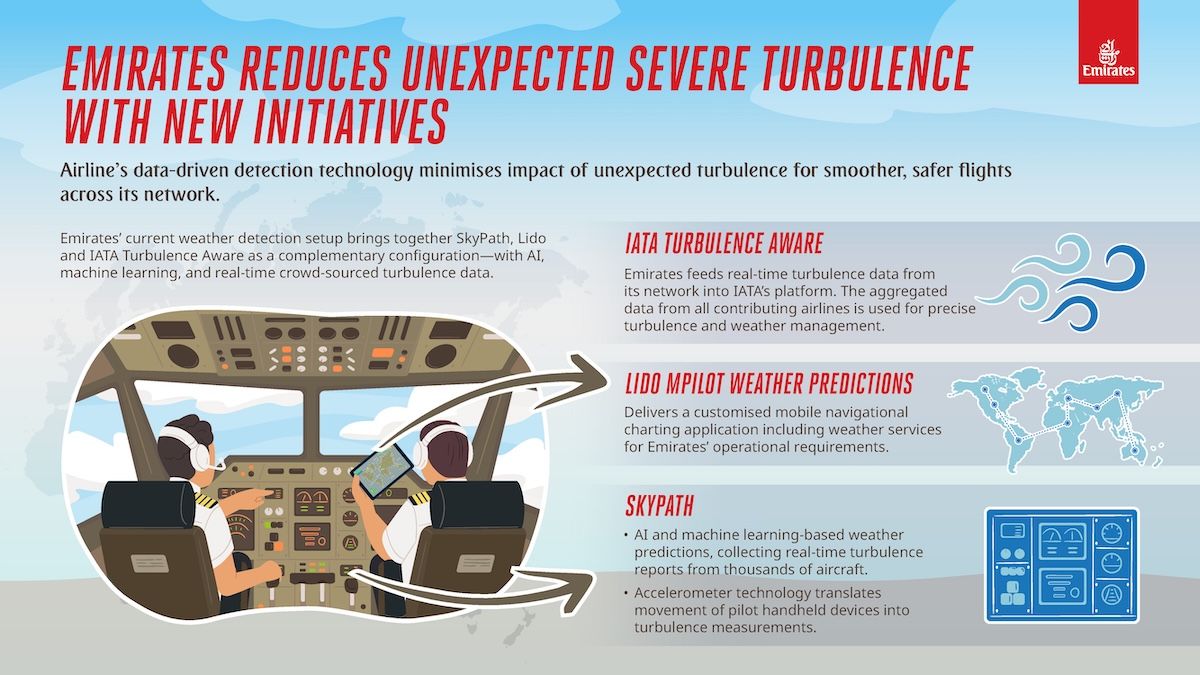Emirates has found that turbulence events are becoming more frequent and severe, and has taken a proactive, data-driven approach to help in the planning of smoother flights.
The airline has adopted a multi-layered strategy that uses multiple information sources to deliver real-time data on the risks of turbulence events. According to Emirates, this approach has helped reduce the number of unexpected severe turbulence events on flights across its network, which helps to enhance the onboard experience for passengers and crew alike.
Emirates’ range of weather detection systems brings together SkyPath, Lido mPilot from Lufthansa Systems, and IATA Turbulence Aware as a complementary configuration, drawing on technologies including AI, machine learning, real-time crowd-sourced turbulence data, and pilot reports.
How the weather detection systems work:
SkyPath: Emirates partnered with SkyPath in 2024 to develop and improve AI and machine learning-based weather predictions that identify turbulence areas that some conventional methods can miss. SkyPath’s platform integrates real-time turbulence reports from thousands of aircraft with cutting-edge analytics, using advanced AI and machine learning to generate accurate predictions, even for areas with no current flight activity or challenging ‘clear air’ turbulence.
SkyPath gathers information from various data sources: Eddy Dissipation Rate (EDR) data for universal turbulence measurements, Automatic Dependent Surveillance–Broadcast (ADSB) transponder data, and SkyPath’s iPad accelerometer technology that translates device movement into precise turbulence measurements that provide pilots with actionable information. This multi-source, AI-driven approach ensures global coverage and prediction accuracy.
Lido mPilot weather predictions: Emirates’ partnership with Lufthansa Systems delivers a customised mobile navigational charting application tailored to the airline’s operational requirements. Through partnerships with sources including the German Weather Service, Lido mPilot provides highly accurate weather reporting, live cloud and convection data, as well as turbulence and icing predictions for enhanced pilot situational awareness. Emirates continuously collaborates with the Lido team to improve weather data quality and global coverage.
IATA Turbulence Aware: Since joining IATA’s Turbulence Aware Programme last year, Emirates has been actively contributing and consuming real-time turbulence data from its flight network across the Middle East, Africa, Asia, and Australia. This data feeds into IATA’s global turbulence platform, which aggregates inputs from participating airlines worldwide to provide a comprehensive, real-time view of atmospheric conditions.
By integrating these insights into its electronic flight bag charting application, Emirates equips its pilots with live, in-situ turbulence visualisations. This enables more informed decision-making in the cockpit, allowing crews to anticipate and avoid turbulent areas, ultimately enhancing flight comfort, operational safety, and fuel efficiency.

Captain Hassan Alhammadi, divisional senior vice president for flight operations at Emirates said: “We recognise that turbulence remains an ongoing challenge that cannot be completely eliminated, but we’re committed to doing everything possible to minimise unexpected severe turbulence encounters through working with partners that share our vision of using advanced technologies and adopting AI to enhance operations. While we are still in the early stages, we are already seeing validation of the potential benefits these systems can deliver.
“While we cannot promise turbulence-free flights, these initiatives have contributed to a significant reduction in unexpected severe turbulence incidents over the past year, helping make journeys safer and more comfortable for our customers.
“Our multi-layer approach with weather prediction and technology partners and active participation in the IATA Turbulence Aware programme also enables us to contribute valuable data and insights to the broader aviation industry as we collectively work to address this growing meteorological challenge.”





